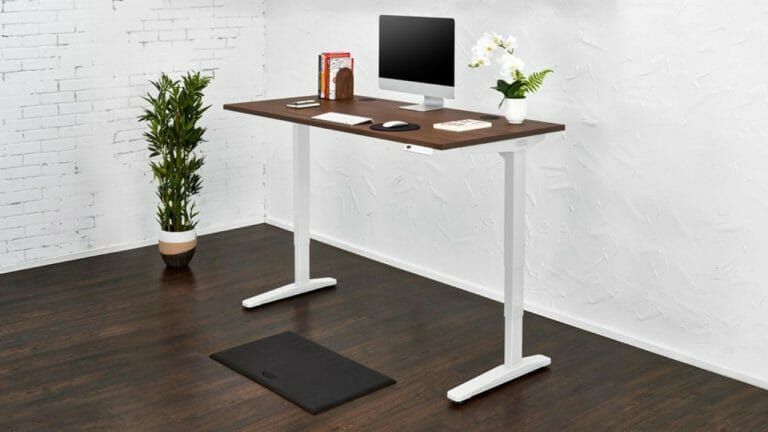Can You Use A Standing Desk All Day Long?
A sedentary lifestyle is bad for you. No doubt, everyone is gushing over the new standing desk trend. But how long is too long in front of a standing desk? Can you use it all day long and stay on your feet?
No, you can’t imagine standing throughout your 8-hour work shift. That’s tiring both physically and mentally. To keep your cardio-metabolic condition under check, alternate between standing and sitting every 20-30 minutes.
Now, if you are planning to use a standing desk, please do it correctly. Follow this guideline to find the ideal time limit you should spend on this ergonomic tool every day.
Is It Possible To Use A Standing Desk All Day?
If you spend most of the day sitting or laying, you are at severe health risk. According to research, a sedentary lifestyle is the main reason obesity is increasing at a rapid rate within America. If you notice, desk jobs are more common in the USA than in any other country. With such lifestyle, workers easily gain body fat, diabetes, high cholesterol level, and so on.
But just because sitting is dangerous, should you start standing the whole day? That’s absurd. Nobody can do that without facing major musculoskeletal issues.
The ideal ratio for standing is 1:1 or 1:2. That means, you can stand one hour and then, spend the next hour sitting. Or, you can stand for one hour and then, spend the next two hours on a chair. Of course, it looks easy. But if you are not used to standing that much, we doubt you will be able to stand for one hour straight without a break.
If you can stand one hour straight, that’s wonderful. Keep it up. But don’t try to challenge your body too much. You can decrease the char break by half an hour if you want. But it’s super important to keep switching from standing to sitting throughout the day.
3 Problems You Can Face For Standing Too Long
Since we are warning you so much about the negative side effects of standing too long, let’s check them out briefly. Shall we?
1. Lower Back Pain
LBP (lower back pain) is the most common symptom found in people who stand for an extended time period. Some occupations like nursing, firefighters, and surgeons have no other option but to deal with it.
Researchers accuse a lack of flexibility in the standing position for this. When you stand straight, there’s not much scope for idling. There’s no back support or arm support like you typically get with an ergonomic chair. It puts too much stress on your lower back particularly the buttocks or the hips area.
Over time, you accumulate the pain and it only becomes worse. Eventually, your ability to stand for a long time reduces due to the excruciating pain shooting up the lower back portion.
2. Stiff Neck
A stiff neck is sometimes caused by excessive standing hours. When we stand in one place, our body works hard. And, so does our neck. We can’t rest on a neck rest like a chair. Such scopes get lost when we choose to work with a standing desk.
Another term for a stiff neck would be muscle fatigue. Just like our minds, our muscles get bored if we stick to one position for too long. That’s the simplest way to understand it.
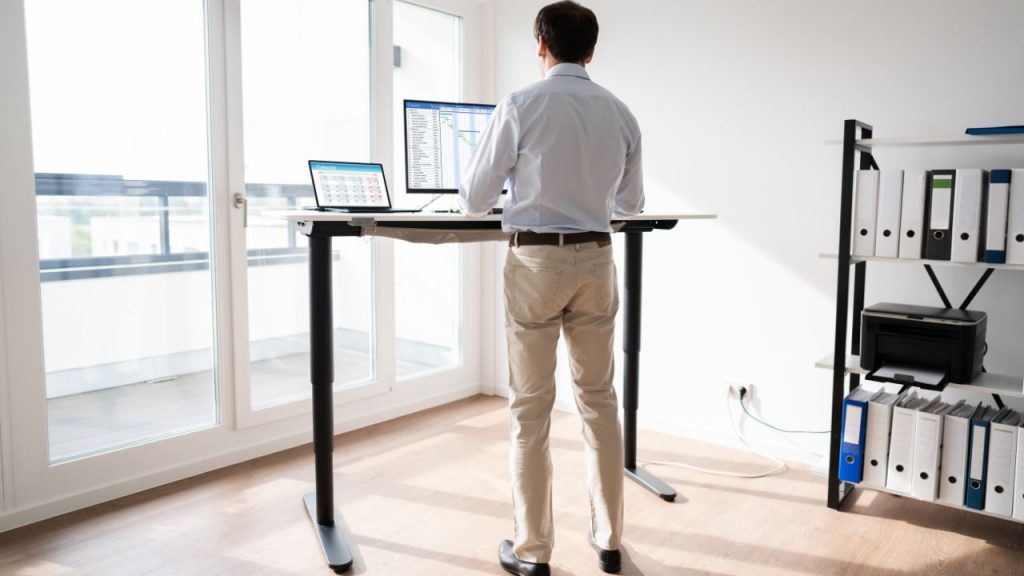
3. Inflammation
When you stand for way too long, it gets harder for the blood flow to reach the bottom of your legs. The lack of blood after a point triggers your body to send more blood in an attempt to compensate for the earlier disturbance. Sudden blood rush can cause inflammation and swelling in your heels particularly.
What’s The Right Way To Use A Standing Desk?
The right approach to using a standing desk is knowing your body. Yes, there’s no ideal time threshold that your body can’t handle. If your feet go numb, no need to continue standing.
For first-timers, who don’t usually stand much throughout the day, start by standing for 5 minutes every 20 minutes. So, you have three turns (3×20=60 minutes) to get up every hour. That’s the safest approach to teaching your body how to stand and work.
However, if your BMI suggests you are in the obese category, you might want to start even smaller. In that case, stand for 5 minutes after every 25 minutes. So, you will have two turns (2×3=60) in an hour. And, you will be standing 10 minutes per hour in front of the desk.
Once your body adjusts to such work patterns, it’s time to move further. Increase your threshold from 5 to 10 minutes every 30 minutes. So, you are standing 20 minutes per hour.
After a while, when you notice improved posture and health, expand it to 15 minutes every half an hour.
Yes, it’s okay to increase your comfort slowly. You don’t have to make the most of your standing desk from the first day. Take your time and let the body adjust. That’s the right approach we would say.
How Do You Increase The Standing Time Gradually?
It’s shown in medical research that you can decrease up to 11% of the overall triglycerides also known as body fat by standing only two hours per day. The benefits don’t end there. Your sugar level decreases (by 2%), and so does your BMI.
Two hours isn’t too much, right? If you work for 4 hours straight, just spend 30 minutes standing in each passing hour.
But unfortunately, some employees find it difficult to stand for two hours throughout the whole day. If you are one of them, here are some tips to increase your tolerance level.
1. Stretching Exercise
Low-intensity exercises work like magic. It can be slow-paced walking, doing yoga, or, simply stretching for 20 minutes. You can practice these exercises early morning or between breaks. It will boost your body flexibility, and standing ability.
Here, keep in mind to avoid weight-lifting or other cardio exercises. Your body tends to demand rest after heavy workouts. And, your aim is completely different.
2. Supportive Shoes
Standing with bare feet is the worst thing you can do. Shoes can be a great way of heel support against rough flooring. Try to use comfy shoes during your time in front of the standing desk.
By comfy, we mean wider souls. That way, your feet will stay flat without any angle causing uneven weight distribution.
You shouldn’t prefer heels for such times as well. Make sure the sole is not rock hard and made of materials that don’t cause sweating.
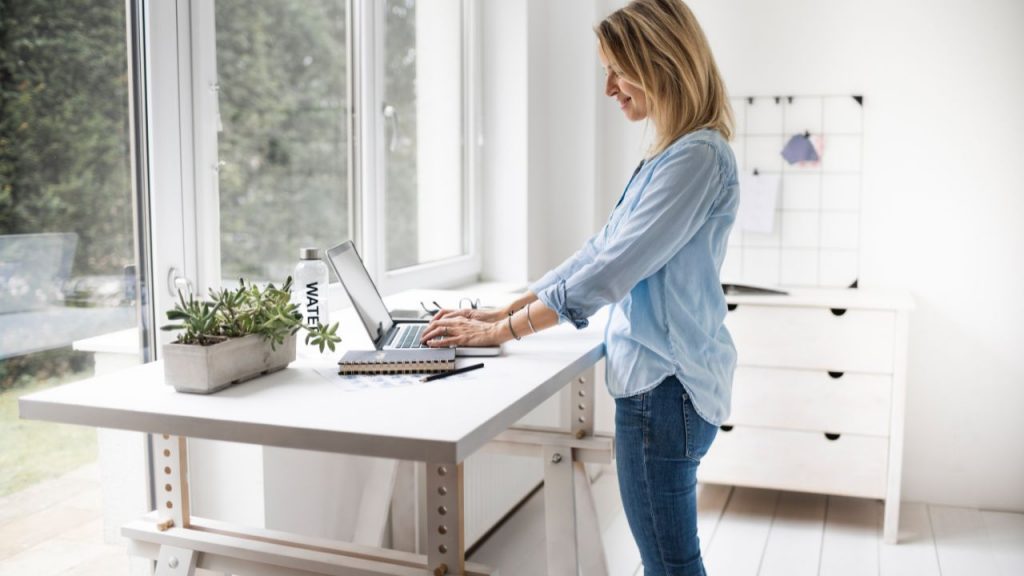
3. Anti-Fatigue Mat
Anti-fatigue mat is a must-have if you own a standing desk. It supports your legs during long periods of standing.
You see, standing on top of a hard floor can become really uncomfortable after a certain point (for most people, after 60 minutes). The blood circulation in the heel area reduces gradually creating a numb feeling.
An anti-fatigue mat doesn’t let your feet turn sore. You can move your legs in subtle motions with this tool. Hence, the blood never stops flowing, unlike the situation we just described. It leads you to stay longer in the place without feeling any discomfort.
4. Healthy Diet
A healthy Diet is a key to almost everything. Avoid eating junk food, beverages, and items rich in sugar. Such food contributes to the joint pain or lower body pain you experience frequently.
This change in eating habits will reduce the level of bad cholesterol in your blood. You will feel less tired while performing low-intensity activities like standing in front of a desk without losing posture.
5. Good Posture
Posture is everything. In fact, you are using a standing desk to help you with your posture. Slouching or bending over the desk for a long time, increases stress on the lower spinal area. That ultimately leads to back pain and causes you to leave the workstation.
If you don’t want that to happen, make sure you are maintaining a good posture all the time. The arm should be parallel to the ground while you work. Adjust the desk so that your ideal posture doesn’t get interrupted.
Instead of ruining your straight posture, get seated if you feel tired. That would be more beneficial.
Before You Go!
We can’t say enough how important standing desks are for your home office. The amount of time spent standing in front of the desk will put some great effects on your overall health. But the only way to reap these benefits is by adjusting the desk height that will suit you better. For that, check out our detailed guide on where to position your standing desk.


![Do Electric Standing Desks Break? [Honest Answer]](https://homethereby.com/wp-content/uploads/2022/07/Do-Electric-Standing-Desks-Break-768x432.jpg)
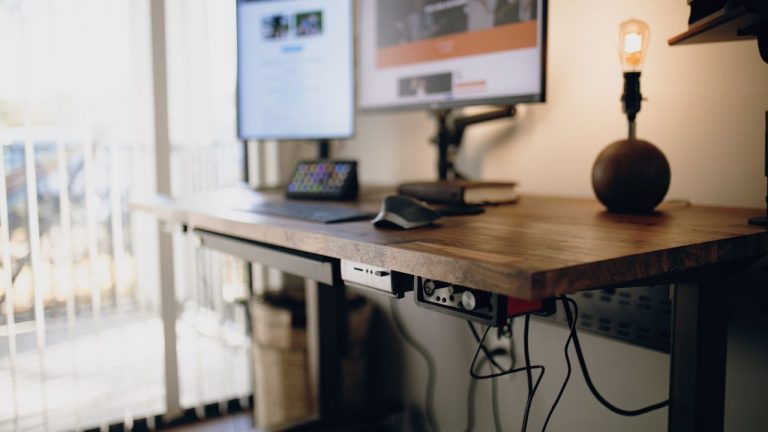
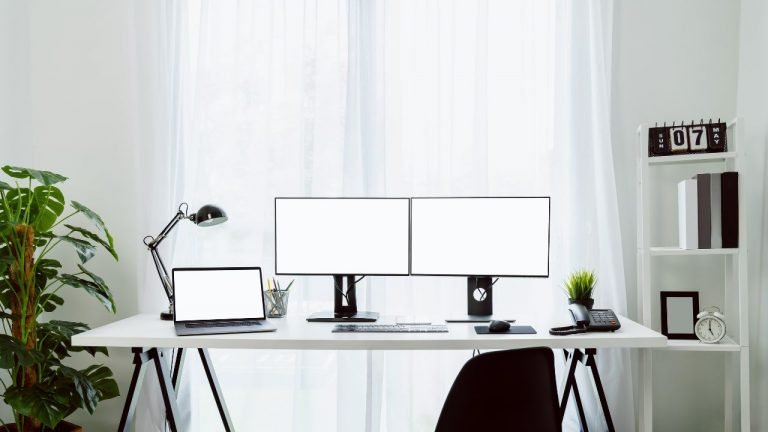
![Crank Vs Electric Standing Desk [7 Differences Explained]](https://homethereby.com/wp-content/uploads/2022/07/How-Much-Should-You-Spend-On-A-Standing-Desk-2-768x432.jpg)

